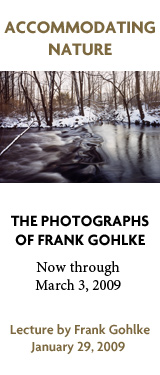Exhibitions
Current, Upcoming and Traveling Exhibitions
The Smithsonian American Art Museum presents an array of changing special exhibitions at both its historic main building in the heart of Washington, D.C.'s downtown cultural district, and at its branch museum, the Renwick Gallery, located nine blocks west near the White House. Exhibition subjects range from single-artist retrospectives to thematic explorations to installations of rarely seen works from SAAM's permanent collection. Special exhibitions at the Renwick Gallery, which open in the spring and fall, focus on contemporary artists as well as traditions in American craft and decorative arts.
Current Exhibitions
Accommodating Nature: The Photographs of Frank Gohlke
Now through March 3, 2009
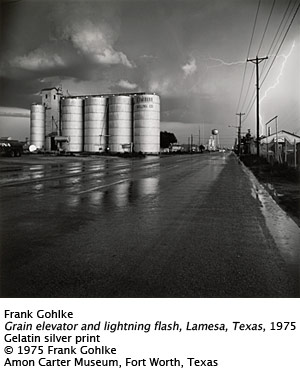
For more than 30 years, Frank Gohlke (b. 1942), a leading figure in American landscape photography, has explored the ways Americans build their lives in a natural world that rarely fits within a traditional pastoral ideal. This retrospective exhibition, which captures Gohlke's longstanding fascination with nature's proclivities for growth, destruction and unexpected change, features 79 photographs—both black-and-white and color prints—spanning the artist's career from the early 1970s through 2004. Rather than celebrating uninhabited landscapes or avoiding evidence of human intrusions, Gohlke's photographs reflect how people interact with an environment that can never be fully controlled. Whether photographing his hometown of Wichita Falls, Texas; the grain elevators that punctuate the vast spaces of the Midwest; the effect of the 1980 volcanic eruption of Mount St. Helens in Washington; or the neighborhoods of Queens, NY, Gohlke deftly captures the tension between humanity and the natural world, exploring how people adapt to the forces of nature both great and small, even within the confines of their own backyards. The exhibition was organized by John Rohrbach, senior curator of photographs at the Amon Carter Museum in Fort Worth, Texas; Toby Jurovics, curator for photography, is the coordinating curator in Washington.
Free Videocast
Watch a videocast interview with Frank Gohlke (via Quicktime or iTunes) with an introduction to the exhibition by curator Toby Jurovics.
Credit
Accommodating Nature: The Photographs of Frank Gohlke is organized by the Amon Carter Museum and is made possible in part by generous support from the Perkins-Prothro Foundation, Exelon Power and the Vin and Caren Prothro Foundation.
The Smithsonian American Art Museum wishes to express its thanks to Charles and Judith Moore and Mark Schwartz and Bettina Katz for their support the exhibition's presentation in Washington, D.C. The Bernie Stadiem Endowment Fund provided additional support for the exhibition.
Graphic Masters I: Highlights from the Smithsonian American Art Museum
Now through May 25, 2009
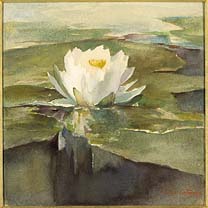
Graphic Masters I: Highlights from the Smithsonian American Art Museum is the first in a series of special installations that celebrate the extraordinary variety and accomplishment of American artists' works on paper. These exceptional watercolors, pastels, and drawings from the early nineteenth century through the 1930s reveal the central importance of works on paper for American artists, both as studies for creations in other media and as finished works of art. Rarely seen works from the museum's permanent collection by masters such as John James Audubon, Romaine Brooks, Childe Hassam, Winslow Homer, John La Farge, Man Ray, John Marin and Georgia O'Keeffe will be featured in the exhibition. Joann Moser, senior curator for graphic arts, selected the artworks in Graphic Masters.
Publication
The accompanying book, Graphic Masters: Highlights from the Smithsonian American Art Museum, is available in the museum's online shop for $19.95.
The Honor of Your Company Is Requested: President Lincoln's Inaugural Ball
Now through January 18, 2010
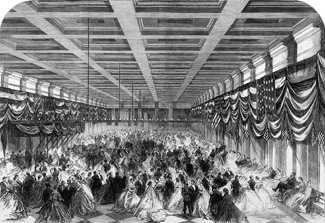
Travel back 143 years to the revelry of Abraham Lincoln's second inaugural ball. This small, focused exhibition celebrates the president's second inaugural ball, held on March 6, 1865 in what is now the museum's historic home. The ball took place as Lincoln's second term began, with the Civil War in its final stages, and only six weeks before Lincoln was assassinated at Ford's Theater nearby. The exhibition, which relates the ball to the building and its history, features ephemera from the inaugural ball, including the invitation and menu as well as engravings illustrating the night's events and other artifacts. From pomp and politics to feasting and fights over food, this was one night destined for the history books. Charles Robertson, author of the recent book Temple of Invention: History of a National Landmark and a specialist in American decorative arts, is the guest curator of the exhibition.
Credit
The exhibition is organized by the Smithsonian American Art Museum with support from the Ford Motor Company Fund.
George Catlin's Indian Gallery
Now through April 26, 2009
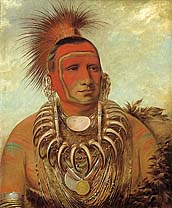
George Catlin’s Indian Gallery celebrates one of the most important collections at the Smithsonian American Art Museum—the nearly complete surviving set of Catlin's Indian Gallery painted in the 1830s and 1840s. It is considered an authentic record of early Plains Indian culture. Catlin, a lawyer turned painter, traveled thousands of miles from 1830 to 1836, following the trail of the Lewis and Clark expedition, to record the "manners and customs" of Native Americans. Catlin visited 50 tribes living west of the Mississippi River from present day North Dakota to Oklahoma. The installation features 287 paintings, portraits, landscapes, and scenes of American Indian life. The paintings are hung in the Grand Salon at the museum's branch, the Renwick Gallery, in a way that recalls the Indian Gallery as Catlin displayed it during the 1840s while touring Europe.
Publication
George Catlin and His Indian Gallery, includes 120 color plates with an illustrated commentary by Joan Troccoli; essays by Brian Dippie, Christopher Mulvey and Therese Heyman; and an introduction by W. Richard West, founding director of the Smithsonian’s National Museum of the American Indian. It is available for $65 ($39.95 softcover) in the museum's store and online.
Back to: Top
Upcoming Exhibitions
2009
The Art and Craft of Greene & Greene (Renwick)
Graphic Masters II: Highlights from the Smithsonian American Art Museum
Renwick Craft Invitational 2009 (Renwick)
What's It All Mean: William T. Wiley in Retrospect
2010
Framing the West: The Expedition Photographs of Timothy H. O'Sullivan
The Art of Gaman: Arts and Crafts from the Japanese American Internment Camps, 1942-1946 (Renwick)
2011
Better Angels of Our Nature: Art During the Civil War and Reconstruction
1934: A New Deal for Artists
February 27, 2009 through January 3, 2010
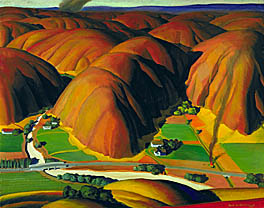
This exhibition celebrates the 75th anniversary of the Public Works of Art Program by drawing on SAAM's unparalleled collection of paintings created for the program, which lasted only six months from mid-December 1933 to June 1934. Artists participating in the federal program were encouraged to depict the American scene, but were free to portray any subject matter. The fifty-six paintings in the exhibition range from portraits to cityscapes and images of city life to landscapes and depictions of rural life. Created by artists from across the United States, the paintings are a lasting visual record of America at a specific moment in time.
Credit
1934: A New Deal for Artists is organized and circulated by the Smithsonian American Art Museum with support from the William R. Kenan, Jr. Endowment Fund and the Smithsonian Council for American Art. The C.F. Foundation in Atlanta supports the museum's traveling exhibition program, Treasures to Go.
The Art and Craft of Greene & Greene (Renwick)
March 13, 2009 through June 7, 2009
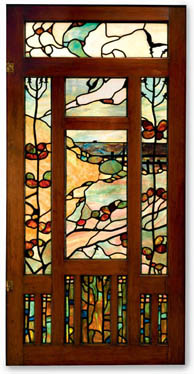
The architecture and decorative arts designed by brothers Charles and Henry Greene a century ago in California are now recognized internationally as among the finest of the American Arts & Crafts movement. Such appreciation is inspired by the Greenes' careful consideration of every detail of the buildings and objects they designed. Like their contemporary Frank Lloyd Wright, the Greenes believed architecture to be no less than a design language for life, imbuing their houses and furnishings with an expressive sensitivity for geography, climate, landscape and lifestyle. The Gamble House, constructed between 1907 and 1909 in Pasadena, California, is one of their best known commissions. The Art and Craft of Greene & Greene, the largest exhibition of their work to date, examines the brothers' legacy with approximately 130 objects representing a variety of media including beautifully inlaid furniture crafted from exotic hardwoods, artfully executed stained glass and metalwork, as well as rare architectural drawings and photographs.
Credit
This exhibition has been organized by The Gamble House, University of Southern California and The Huntington Library, Art Collections and Botanical Gardens, California, in cooperation with the Renwick Gallery, Smithsonian American Art Museum, and the Museum of Fine Arts, Boston. The James Renwick Alliance supports the exhibition's presentation at the Renwick Gallery.
Jean Shin: Common Threads
May 1, 2009 through July 26, 2009
It's often said that one person's trash is another's treasure. Jean Shin is nationally recognized for her transformative installations that take the castoffs of consumer society and give them new life. Scavenging discarded objects such as worn shoes, lost socks, broken umbrellas, and old lottery tickets, Shin dismantles, alters, and reconstructs. The resulting assemblages consist of hundreds, sometimes thousands, of seemingly identical objects gathered from friends, relatives, and perfect strangers. This exhibition will feature six large-scale installations created since 2000 including Chance City, a sprawling landscape of losing lottery tickets painstakingly stacked to create a city of cards; Chemical Balance, a towering arrangement of empty pill bottles that speaks to a dependency on prescription medications; and Unraveling, a dense, brightly colored web of woolen threads that visualizes the network of relationships within the Asian American arts community.
A new project, Everyday Monuments, also will debut in the exhibition. The installation will include several hundred trophies gathered from Washington, D.C.-area residents. This aspect of collaboration is an integral part of Shin's process, and many of her recent projects emerge from a close dialogue with the organizing venue and surrounding population. As a result, her installations often function as collective portraits reflecting the identity of a specific community. The exhibition is organized by Joanna Marsh, The James Dicke Curator of Contemporary Art.
Credit
The Smithsonian American Art Museum wishes to thank the Diane and Norman Bernstein Foundation, Inc., Janice Kim and Anthony Otten, Nion McEvoy, and Nick and Holly Ruffin for their generous support of the exhibition.
Graphic Masters II: Highlights from the Smithsonian American Art Museum
June 19, 2009 through January 10, 2010
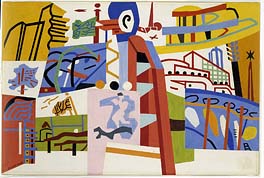
Graphic Masters II: Highlights from the Smithsonian American Art Museum, the second in a series of special installations, celebrates the extraordinary variety and accomplishment of American artists' works on paper. These exceptional watercolors, pastels, and drawings from the 1920s to 1990 reveal the central importance of works on paper for American artists, both as studies for creations in other media and as finished works of art. Rarely seen works from the museum's permanent collection by artists such as Stuart Davis, Edward Hopper, Willem de Kooning, Joseph Stella, Grant Wood and Andrew Wyeth will be featured in the exhibition. Joann Moser, senior curator for graphic arts, selected the artworks in Graphic Masters.
Publication
The accompanying book, Graphic Masters: Highlights from the Smithsonian American Art Museum, is available in the museum's online shop for $19.95.
Renwick Craft Invitational 2009 (Renwick)
August 7, 2009 through January 3, 2010
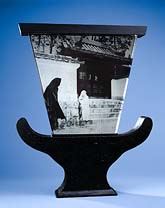
The Renwick Craft Invitational 2009 is the fourth in a biennial exhibition series, established in 2000, that honors the creativity and talent of craft artists working today. The exhibition will feature the work of ceramic artist Christyl Boger, fiber artist Mark Newport, glass artist Mary Van Cline and ceramic artist SunKoo Yuh. The artists were chosen by Kate Bonansinga, director of the Stanlee and Gerald Rubin Center for the Visual Arts at the University of Texas at El Paso; Jane Milosch, Renwick Gallery curator; and Paul J. Smith, director emeritus of the Museum of Arts & Design. Bonansinga is the guest curator for the exhibition.
Boger (b. 1959), an assistant professor at Indiana University in Bloomington, creates large-scale gilded ceramic figurines that incorporate contemporary props. Newport (b. 1964), artist-in-residence and head of the fiber department at the Cranbrook Academy of Art in Bloomfield Hills, Michigan, examines issues of masculinity through knitted superhero costumes. Van Cline (b. 1954), who lives and works in Seattle, uses plate glass and pâte de verre to construct sculptural pieces that often incorporate black-and-white photographs. Yuh (b. 1960), an associate professor at the University of Georgia in Athens, creates densely layered ceramic sculptures that explore complex issues of family, faith and community with Eastern and Western imagery.
Credit
The Ryna and Melvin Cohen Family Foundation generously supports the Renwick Craft Invitational 2009.
What's It All Mean: William T. Wiley in Retrospect
October 2, 2009 through January 24, 2010
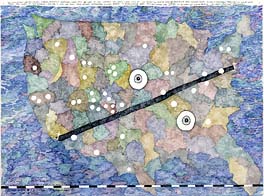
William Wiley (b. 1937) has stood the test of time in the face of changing styles, successive movements, critical theories and passing fashion. His self-deprecating humor and sense of the absurd make his art accessible to even those who do not comprehend his more ambiguous ideas, allusions, narratives, private symbols and layers of meaning. Puns are fun, and they make more palatable his deadly serious commentary on war, pollution, global warming, racial tension and other threats to contemporary civilization. What's It All Mean: William T. Wiley in Retrospect, the first full-scale look at Wiley's career since 1979, will feature approximately 100 works from the late 1960s to the present, borrowed from public and private collections as well as from the artist. It will provide a serious overview of Wiley's career while exploring important themes and ideas expressed in his work. Joann Moser, senior curator for graphic arts, is the curator of the exhibition.
Credit
Generous support for What's It All Mean: William T. Wiley in Retrospect was provided by the Andy Warhol Foundation for the Visual Arts, Gretchen and John Berggruen, the Charles Cowles Charitable Trust, Sheila Duignan and Mike Wilkins, Sakurako and William Fisher, the Lipman Family Foundation, James and Marsha Mateyka, Rita J. Pynoos, Betty and Jack Schafer, Roselyne C. Swig, and the Tides Foundation: Art 4 Moore Fund. The exhibition is organized and circulated by the Smithsonian American Art Museum. The C.F. Foundation in Atlanta supports the museum's traveling exhibition program, Treasures to Go.
Framing the West: The Expedition Photographs of Timothy H. O'Sullivan
February 12, 2010 through May 9, 2010
Timothy H. O'Sullivan (1840–1882), a photographer for two of the most ambitious geological surveys of the 19th century, is likely to have witnessed more of the American interior than any photographer of his generation. O'Sullivan traversed the mountain and desert west for six seasons between 1867 and 1874 as part of government-sponsored expeditions led by Clarence King and Lt. George Wheeler, returning to Washington with hundreds of photographs of newly explored landscapes. These images reveal a photographer whose reach was far beyond practical documentation, exhibiting a forthright and rigorous style formed in response to the American west. Faced by terrain that was physically challenging, and without previous artistic examples to follow, O'Sullivan created a mature body of work that was without precedent. Framing the West: The Expedition Photographs of Timothy H. O'Sullivan, the first major look at O'Sullivan photographs in more than 25 years, is a critical re-examination of the artist's work and his continuing influence on American photography. The exhibition and accompanying catalog will present a careful analysis of O'Sullivan's images, the conditions under which they were made, the influences that shaped his work and a study of the lasting historic importance of this remarkable body of photographs. Toby Jurovics, curator for photography, is the exhibition curator.
The Art of Gaman: Arts and Crafts from the Japanese American Internment Camps, 1942-1946 (Renwick)
March 5, 2010 through August 1, 2010
The Art of Gaman will showcase arts and crafts made by Japanese Americans in U.S. internment camps during World War II. While incarcerated, the internees tried to gaman, a Japanese word that means to bear the seemingly unbearable with dignity and patience. Housed in tar-paper covered barracks furnished with nothing more than metal cots, the internees used scraps and found materials to create furniture, toys and games, musical instruments, pendants and pins, purses, and ornamental displays. These objects became essential both for simple creature comforts and emotional survival. This exhibition presents an opportunity to educate a new generation of Americans about the internment experience and will provide a historical context through archival photographs and artifacts. The exhibition, organized by San Francisco-based author and guest curator Delphine Hirasuna, with the cooperation of the Japanese American Citizens League, will feature approximately 150 objects, many of which are on loan from former internees or their families. The exhibition is based on Hirasuna's 2005 book The Art of Gaman.
Christo and Jeanne-Claude: Remembering the Running Fence, Sonoma and Marin Counties, California, 1972-76, A Documentation Exhibition
April 2, 2010 through September 26, 2010
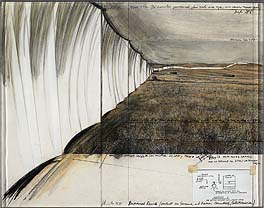
The most lyrical and spectacular of Christo and Jeanne-Claude's epic projects was the Running Fence, Sonoma and Marin Counties, California, 1972-76, a white fabric and steel-pole fence, 24 1/2 miles long and 18 feet high, across the properties of 59 ranchers in Sonoma and Marin Counties north of San Francisco. The project attracted far wider public involvement than any previous work of art, including 18 public hearings, three sessions in the Superior Court of California and the first environmental impact report ever done for a work of art. Paid for entirely by the artists, the Running Fence existed for only two weeks. It survives today as a memory and through the artwork and documentation by the artists—drawings, collages, photographs, film and components. This collection of artwork, including nearly 50 major preparatory drawings and collages by Christo, and documentation was acquired in 2008 from the artists by the Smithsonian American Art Museum.
The exhibition celebrates this significant acquisition and presents an opportunity to re-assess after 30 years the impact of one of the artists' best-known projects. In addition, the exhibition will introduce the Running Fence to a new generation that has grown up since its creation. The exhibition will trace Christo and Jeanne-Claude's imaginative process through Christo's early preparatory drawings and collages that preceded the final installation in California, and reveal how imagination and reality coincided by comparing these works with photographs of the completed project.
Better Angels of Our Nature: Art During the Civil War and Reconstruction
March 11, 2011 through September 5, 2011
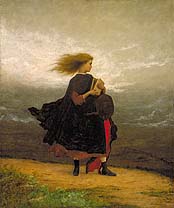
Better Angels of Our Nature will explore the impact of the Civil War and its aftermath on the visual arts in America using some of the finest artworks made during this period by leading figures such as Albert Bierstadt, Frederic Church, Winslow Homer, Eastman Johnson, Hiram Powers, and John Rogers. Although the exhibition will include photographs by Alexander Gardner and Timothy O'Sullivan, the focus will be on how artists addressed the metaphorical war, dealing allegorically or elliptically with the issues of internal warfare, the future of the union, abolition and race relations, and the post-war search for a new American identity. These artists' solutions resulted in some of the most compelling landscapes and genre paintings of the mid-nineteenth century, often containing layers of meaning beyond their war-related allusions. Eleanor Jones Harvey, chief curator, is the exhibition curator.
Back to: Top
Traveling Exhibitions
Elihu Vedder's Drawings for the Rubáiyát of Omar Khayyám
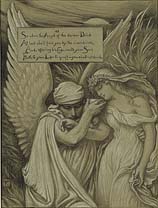
Since the first English translation in 1859, hundreds of editions of the Rubáiyát, written around 1120 by the Persian mathematician, astronomer and poet Omar Khayyám, have been published. The poem expounds on the transience of existence and the uselessness of science or religion to untangle the knotted meaning of life. Elihu Vedder (1836–1923), an ardent admirer of the verses, arranged the most famous and elaborate edition in the 1880s. Vedder created the designs for the entire book—its cover, lining paper, compelling drawings and eccentric hand-drawn letters—which set the standard for an artist-designed book in America and England at the time. This exhibition features 55 drawings from the museum's collection. To browse the full collection online, visit the museum's microsite at AmericanArt.si.edu/vedder.
Tour
The exhibition travels to the Brandywine River Museum in Chadds Ford, Pennsylvania (March 15, 2008–May 18, 2008) and the Phoenix Art Museum (November 14, 2008–February 10, 2009).
Credit
Elihu Vedder's Drawings for the Rubáiyát of Omar Khayyám is organized and circulated by the Smithsonian American Art Museum. The exhibition's tour is supported in part by the C.F. Foundation, Atlanta, and the William R. Kenan, Jr. Endowment Fund.
Earl Cunningham’s America
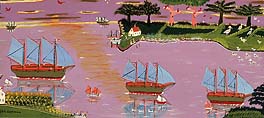
Earl Cunningham’s America examines the paintings of Earl Cunningham (1893–1977), one of the foremost folk artists of the twentieth century. This retrospective presents the artist as a folk modernist who used flat space and brilliant color to create sophisticated compositions with complex meanings about the nature of American life. The exhibition and the fully-illustrated catalogue trace the story of Cunningham’s life and place his work in the context of the folk art revival that brought Edward Hicks, Grandma Moses, Horace Pippin and other folk masters to national attention. Virginia Mecklenburg, senior curator at the museum, organized the exhibition.
Tour
The exhibition travels to the American Folk Art Museum in New York City (March 4, 2008 – August 31, 2008); the
Fenimore Art Museum in Cooperstown, New York (September 26, 2008 – December 31, 2008); and The Mennello Museum of American Art in Orlando, Florida (March 6, 2009 – August 2, 2009).
Publication
The catalogue is written by Mecklenburg, with essays by Wendell D. Garrett, senior vice president for American decorative arts at Sotheby's in New York City; and Carolyn J. Weekley, the Juli Grainger Director of Museums at Colonial Williamsburg. It is available for $45 in the museum's store and online.
Credit
Earl Cunningham's America is organized by the Smithsonian American Art Museum. The exhibition is made possible by generous support from Darden Restaurants Foundation; the Elizabeth Morse Genius Foundation; the Arts and Cultural Affairs Office of Orange County, Fla.; CNL Financial Group; Bright House Networks; Lockheed Martin; and Friends of The Mennello Museum of American Art. The exhibition's tour is supported in part by the C. F. Foundation, Atlanta.
Passing Time: The Art of William Christenberry
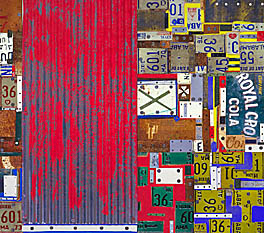
William Christenberry (b. 1936) looks for the spirit of Southern culture in the landscape and architecture of rural Alabama. Drawing upon his formal training, family traditions and a lasting relationship with his native home in Hale County, Christenberry has spent the last fifty years creating a remarkable body of work that is an exploration of all aspects of life and experience. This exhibition, not a retrospective but a survey of past and present work, includes fifty-three photographs, drawings, paintings, sculptures and building constructions. Though his work is inspired by the American South, Christenberry's overall themes are universal, touching on family, culture, nature and the spiritual. His artworks are poetic assessments of a sense of place, landscape, aging, memory and the passing of time.
Tour
The exhibition travels to the Telfair Museum of Art in Savannah, Georgia (May 14, 2008 – September 28, 2008) and the Cheekwood Botanical Garden and Museum of Art in Nashville, Tennessee (March 14, 2009 – June 14, 2009).
Credit
Passing Time: The Art of William Christenberry is organized by the Smithsonian American Art Museum. The exhibition's tour is supported in part by the C. F. Foundation, Atlanta and the William R. Kenan Jr. Endowment Fund.
Over the Top: American Posters from World War I
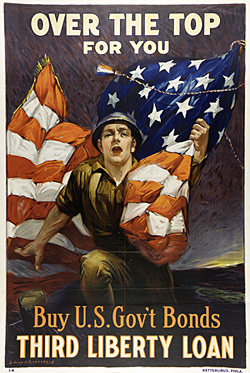
Over the Top: American Posters from World War I features fifty-nine war bond posters, focusing on the four Liberty Loan campaigns, the War Savings Stamp program, the Victory Loan and support for the Red Cross. These persuasive images, with bold graphics and concise commands, encouraged citizens to support the troops, contribute to the Red Cross and buy bonds to finance America's participation in the war. The posters, selected from the collection of Thomas and Edward Pulling, are a fascinating window into the American experience in the early twentieth century.
Tour
The exhibition will be on view at the Norman Rockwell Museum in Stockbridge, Massachusetts (November 8, 2008 – January 25, 2009).
Credit
Over the Top: American Posters from World War I is organized by the Smithsonian American Art Museum. The exhibition's tour is supported in part by the C.F. Foundation, Atlanta and the William R. Kenan Jr. Endowment Fund.
Modern Masters from the Smithsonian American Art Museum
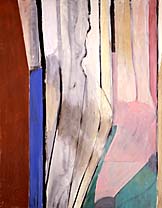
Modern Masters from the Smithsonian American Art Museum features forty-three key paintings and sculptures by thirty-one of the most celebrated artists who came to maturity in the 1950s. Through three broadly-conceived themes that span two decades of creative genius —"Significant Gestures," "Optics and Order" and "New Images of Man"—Modern Masters examines the complex and heterogeneous nature of American abstract art in the mid-twentieth century. Featured artists include Jim Dine, David Driskell, Sam Francis, Philip Guston, Grace Hartigan, Hans Hofmann, Franz Kline, Louise Nevelson, Anne Truitt and Esteban Vicente.
Tour
The exhibition debuts at The Patricia & Phillip Frost Art Museum at Florida International University in Miami (November 29 – March 1, 2009); the exhibition then travels to the Westmoreland Museum of American Art in Greensburg, Pennsylvania (June 14, 2009 – September 6, 2009), the Dayton Art Institute in Dayton, Ohio (October 17, 2009 – January 10, 2010), the Telfair Museum of Art in Savannah, Georgia (November 13, 2010 – February 5, 2011), the Cheekwood Botanical Garden and Museum of Art in Nashville, Tennesee (March 19, 2011 – June 19, 2011) and the Reynolda House Museum of American Art in Winston-Salem, North Carolina (October 7, 2011 – January 1, 2012).
Publication
Modern Masters: American Abstraction at Midcentury, the fully illustrated catalog co-published by the Smithsonian American Art Museum and D Giles Limited (London), is forthcoming. Written by Mecklenburg with contributions by Tiffany Farrell, the book features an essay and biographical information on the 31 artists whose work is included in the exhibition. It will be available this fall for $65 ($45 softcover) at the museum's store, tour venues, and online.
Credit
The Smithsonian American Art Museum is grateful to our generous contributors for their support of Modern Masters from the Smithsonian American Art Museum. The William R. Kenan Jr. Endowment Fund provided support for the publication. The C. F. Foundation in Atlanta supports the museum's traveling exhibition program Treasures to Go. Members of the Smithsonian Council for American Art contribute to the museum's national programs.
Back to: Top
Pictured
top
:
Frank Gohlke, Grain elevator and lightning flash, Lamesa, Texas, 1975, gelatin silver print ©
1975 Frank Gohlke. Amon Carter Museum, Fort Worth, Texas
Pictured
second
:
John La Farge, Water Lily in Sunlight, ca. 1883, watercolor on paper, sheet: 8 1/4 x 8 1/4 in. (21.0 x 20.8 cm), Smithsonian American Art Museum, Gift of John Gellatly
Pictured
third
:
Lincoln's inaugural ball, March 6, 1865, Illustration from Illustrated London News, April 8, 1865, National Portrait Gallery, Smithsonian Institution
Pictured
fourth
:
George Catlin, Shon-ta-yi-ga, Little Wolf, a Famous Warrior, 1844, oil on canvas, 29 x 24 in. (73.7 x 60.9 cm), Smithsonian American Art Museum, Gift of Mrs. Joseph Harrison, Jr.
Pictured
fifth
:
Ross Dickinson, Valley Farms, 1934, oil on canvas, 39 7/8 x 50 1/8 in. (101.4 x 127.3 cm.), Smithsonian American Art Museum, Transfer from the U.S. Department of Labor
Pictured
sixth
:
Entry-hall window, Jennie A. Reeve house, Long Beach; 1903-1904, Private Collection, New York. Photograph courtesy of Sotheby's, New York
Pictured
seventh
:
Stuart Davis, Impression of the New York World's Fair (mural study, Communications Building, World's Fair, Flushing, New York), 1938, gouache on paperboard, sheet: 14 3/4 x 22 1/8 in. (37.5 x 55.9 cm.), Smithsonian American Art Museum, Transfer from the United States Information Agency through the General Services Administration
Pictured
eighth
:
Mary Van Cline, The Listening Point, 1999, photosensitive cast glass and black pate de verre, 25 1/2 x 20 5/16 x 4 in. (64.8 x 51.6 x 10.2 cm), Smithsonian American Art Museum, Gift of the James Renwick Alliance
Pictured
ninth
:
William T. Wiley, Portrait of Radon, 1982, watercolor and felt-tipped pen and ink on paper, sheet: 22 1/4 x 29 7/8 in. (56.5 x 75.9 cm), Smithsonian American Art Museum, Museum purchase
Pictured
tenth
:
Christo, Running Fence, Project for Sonoma and Marin Counties, California, 1975, black-and-white photograph, fabric, metal staples, charcoal, charcoal pencil, pencil, pastel, crayon, photocopied diagram and masking tape on paperboard, 22 1/8 x 28 1/8 x 1 1/8 in. (55.9 x 71.1 cm), Smithsonian American Art Museum, Museum purchase
Pictured
eleventh
:
Eastman Johnson, The Girl I Left Behind Me, 1870-1875, oil on canvas, 42 x 34 7/8 in. (106.7 x 88.7 cm.), Smithsonian American Art Museum, Museum purchase made possible in part by Mrs. Alexander Hamilton Rice in memory of her husband and by Ralph Cross Johnson
Pictured
twelfth
:
Elihu Vedder, (Illustration for Rubáiyát of Omar Khayyám) The Cup of Death, 1883-1884, chalk, pencil and ink on paper, sheet: 19 3/8 x 14 7/8 in. (49.1 x 37.7 cm), Smithsonian American Art Museum, Museum purchase and gift from Elizabeth W. Henderson in memory of her husband Francis Tracy Henderson
Pictured
thirteenth
:
Earl Cunningham, Blue Sail Fleet Returns, after 1949, oil on fiberboard, 16 1/2 x 36 1/4 in. (41.8 x 92.1 cm), Smithsonian American Art Museum, Gift of Mr. and Mrs. Michael Mennello
Pictured
fourteenth
:
William Christenberry, Alabama Wall I, 1985, metal and tempera on wood, 45 3/8 x 50 1/2 in. (115.3 x 128.3 cm.), Smithsonian American Art Museum, Museum purchase
Pictured
fifteenth
:
Sidney H. Riesenberg, Over the Top for You, 1918, 30 x 20 in. (76.2 x 50.8 cm), Lent by Thomas L. and Edward L. Pulling
Pictured
bottom
:
Richard Diebenkorn, Ocean Park, No. 6, 1968, oil on canvas, 92 x 72 in. (233.7 x 182.9 cm), Smithsonian American Art Museum, Gift of Arthur J. Levin in memory of his beloved wife Edith

